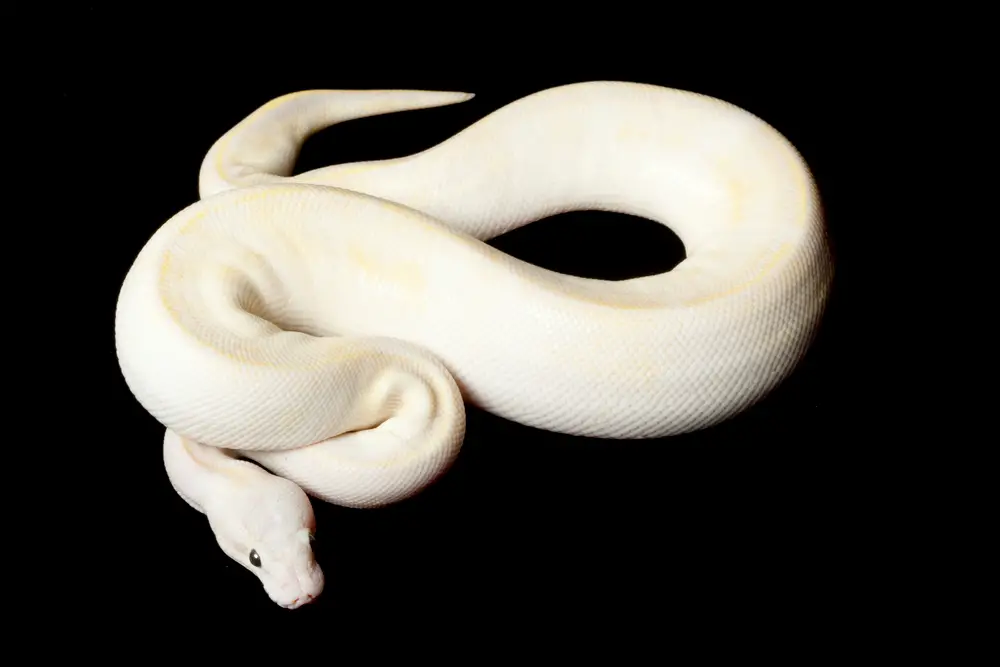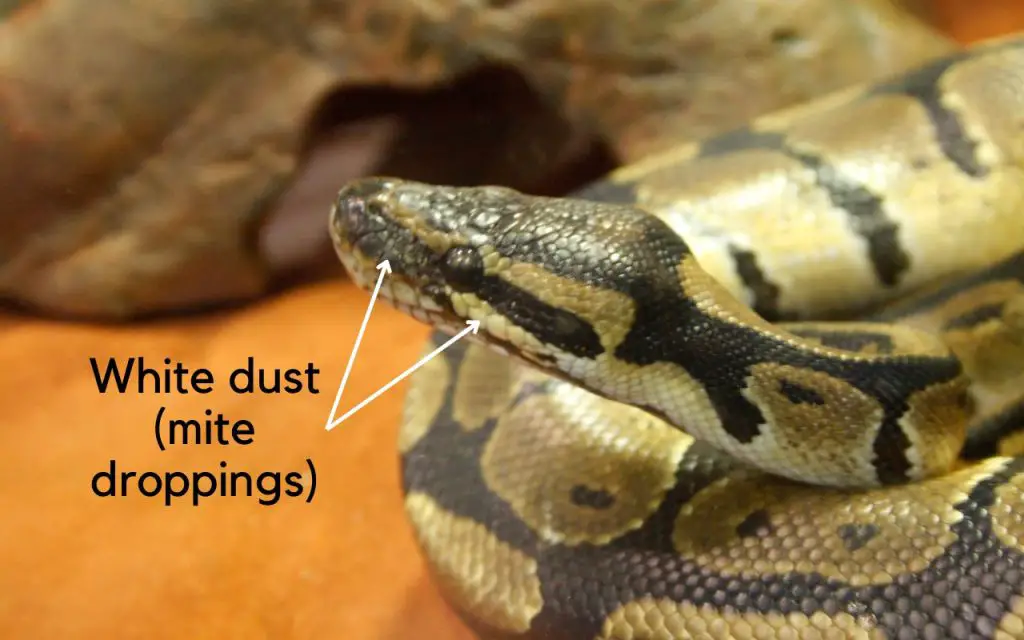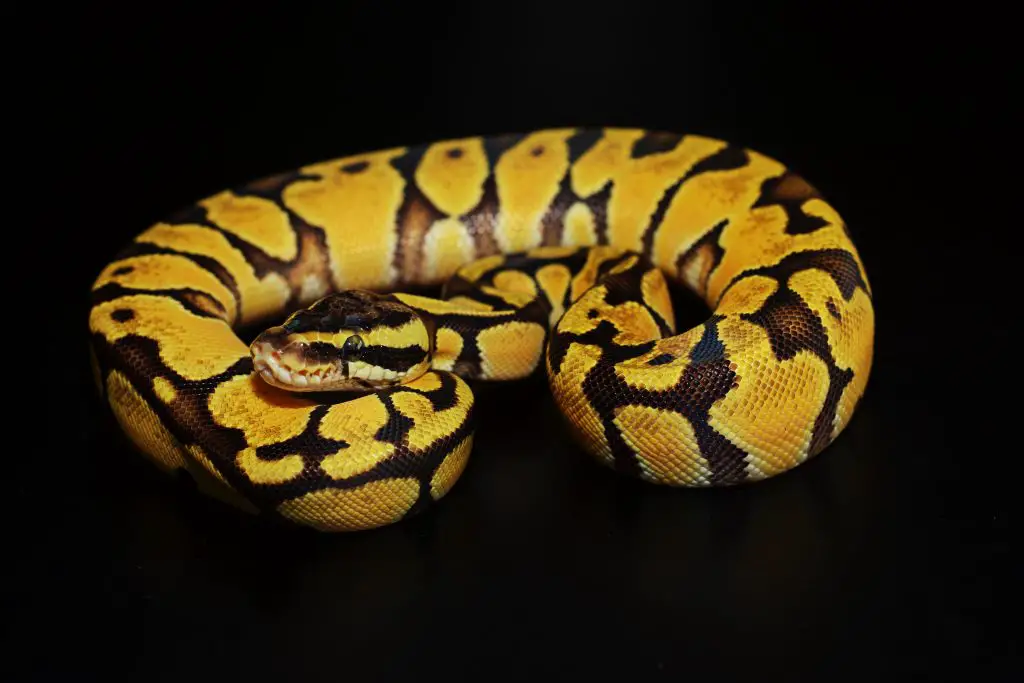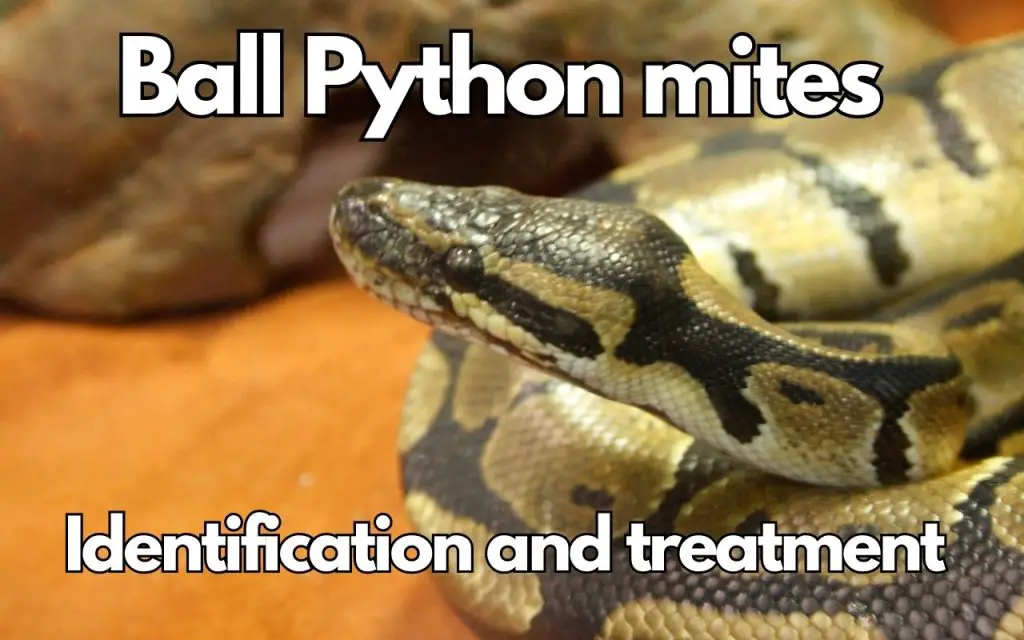Ball Python mites are one of the single most annoying problems you could encounter, thanks to their habit of spreading around the room and hiding in nooks and crannies. Not to mention the fact that they will genuinely degrade your snake’s health! Unlike other common illnesses such as respiratory infections and scale rot, mites are an ectoparasitic infestation known as Acariasis. What this means in real terms is that you’ll need to treat the snake and its enclosure.
In this post, I’m going to tell you everything you need to know about identifying and treating snake mites on Ball Pythons…
What are Snake Mites?
Snake mites (Ophionyssus natricis) are tiny ectoparasites that primarily feed on the blood of reptiles. They’re about 1mm in total length, black, and mobile.
If left unchecked, they can cause a multitude of problems for our beloved Ball Pythons, ranging from minor irritations to severe health issues like sepsis and anemia.

The Snake Mite Life Cycle
Understanding their life cycle is key to effective treatment. Snake mites don’t just use your snake as a breeding ground, they also lay their eggs in the enclosure, and occasionally wander around on surfaces to look for new snakes to colonize.
Their life cycle includes five stages:
- Egg: Female mites lay eggs, which are often off the host in crevices of the snake’s habitat.
- Larvae: These stay close to their eggs, and quickly perish if humidity is low.
- Protonymphs: Larvae molt into protonymphs—tiny eight-legged critters.
- Deutonymphs: These are similar to protonyphs, but are preparing for their change into adults.
- Adults: have a harder exoskeleton, are mobile, and more resistant to desiccation (drying out).
| Stage | Activity |
| Egg | Waiting to hatch |
| Larvae | Preparing for their first molt |
| Protonymph | Growing and start feeding |
| Deutonymph | Preparing for their final molt |
| Adults | Feeding, breeding, and laying eggs |
How to Identify Snake Mites on Ball Pythons
In my experience, one of the first signs of mites on Ball Pythons is black dots in the bottom of the water dish. Infected snakes often soak as their first defence, even if you don’t always see them in the act. By doing this they generally manage to drown quite a few, and that is what the black dots are.
This isn’t the only sign, however. Upon close inspection, you might notice:
- Tiny black dots moving on your snake.
- Your snake soaking more than usual, and trying to submerge as much of its body as it possibly can.
- White ‘dust’ (mite feces) around the scales.
- Restlessness or excessive rubbing against enclosure surfaces.

How Do Ball Pythons Get Mites?
The most common way that Ball Pythons get mites is through the introduction of a new snake to your collection. It’s vital that you quarantine and observe any new pet in a basic enclosure so that you can notice anything untoward.
Like most ectoparasites, mites are pretty good at getting around, so on a live animal isn’t the only way they could reach your pet. Other ways include:
- Introduction of a new snake: Always quarantine new snakes.
- Contaminated equipment: From pet stores or shows.
- Infested feeders: Mites can hitch a ride on feeder animals. Why not just try feeding frozen-thawed and eliminate this possibility?
How to Get Rid of Snake Mites
- Quarantine: First and foremost, isolate the affected snake.
- Clean and disinfect: Deep clean the entire enclosure and replace the substrate.
- Treat the snake: Consult a veterinarian for effective treatments or a learn from a trusted breeder/exotics store. The best treatments are soaking in lukewarm water with dish soap, or mild pesticides. If this doesn’t work, you will need to visit a veterinarian for something a little stronger, like Ivermectin.
Check out the video below for some ideas. I personally think it’s one of the best videos on Youtube on the subject:
Snake Mite Spray: How Effective Is It?
While many sprays in the market claim to eradicate mites, their efficacy can be hit or miss. From my experience they can be effective for mild infestations.
Notwithstanding, it is true that they might not penetrate all crevices or affect eggs. Many of them are also toxic to your snake if you use them incorrectly. Be particularly cautious with anything that isn’t ready mixed. Buying something that is pre-mixed and already in a spray bottle is much safer!
How to Get Rid of Ball Python Mites Naturally
The most natural method overall is soaking, which is the go-to method employed by the snakes themselves, after all. As mentioned earlier, a lukewarm bath in natural/unscented dish soap is a very safe way to go.
Additionally, you can also use olive oil. Coating the snake with viscous material like this is thought to suffocate the mites and kill them off. Personally, I have tried this and didn’t find it particularly effective.
One option that is often touted as an effective treatment is diatomaceous earth. Personally, I find this stuff pretty messy, considering you need to sprinkle it around the enclosure. I’m also put off by the fact that several keepers have told me they tried it and it simply didn’t work.
On the other hand, predatory mites (Taurrus mites) are genuinely effective – and as natural as you can get. They are live mites that prey on parasitic mites, and will eradicate them from your snake and its enclosure.
Not only are predatory mites effective, they are probably the only option for clearing mites out large enclosures without completely dismantling them.
Can Snake Mites Live on Humans?
While they might crawl on you during handling, they don’t infest humans. They’re specialized for reptiles, but it’s still advised to wash your hands after handling an infested snake.
How Far Can Snake Mites Crawl?
The biggest mistake you could make with snake mites is thinking that they’ll stick to one enclosure, or even one side of the room. They go everywhere!
They can crawl several feet in search of a host, and even hitch a ride on your clothing. This is why quarantining an infested snake is crucial to prevent the spread.

Snake Mites and Wooden Vivariums
Wood can be problematic when it comes to getting rid of mites because they absolutely love it. Mites lay eggs in crevices, making wooden vivariums particularly convenient from them. Contrast this with tubs or pvc enclosures, for example, which has smooth surfaces and limited hiding places.
Wooden vivariums are also harder to disinfect than plastic or glass enclosures. The best option for truly cleaning them is bleach, but guess what: bleach can poison your snakes to death if you aren’t careful!
Why Snake Mites Are Hard to Eliminate from Bioactive Setups
The complexity of bioactive setups, with live plants and microfauna, offers mites plenty of hiding places. Eggs can be laid in the soil or under bark, and the whole setup quickly becomes a breeding ground for them.
My take on this is that if you get mites in a bioactive setup, predatory mites are the only viable solution for controlling them.
Ball Python Mites: Final Thoughts…
The battle against snake mites is not for the faint-hearted. But with vigilance, proper care, and the right strategies, it’s a battle you can win. Always remember that prevention is better than cure. Keeping a clean environment and regularly checking your Ball Pythons will ensure both you and your snake remain happy.
If you have a healthy Ball Python, or even several, it’s entirely possible to never get snake mites. Just remember, you must always quarantine any new pet for at least four weeks. During this time you can observe it just in case it has some uninvited guests with it.
For more information on health issues you can check out the following articles:

